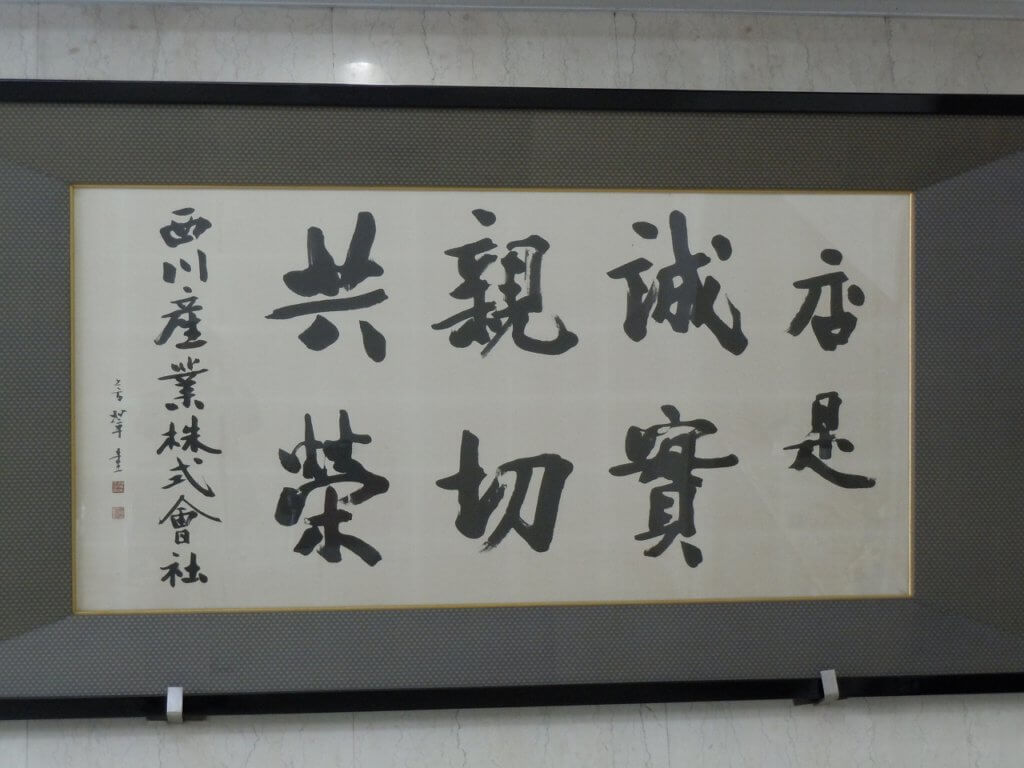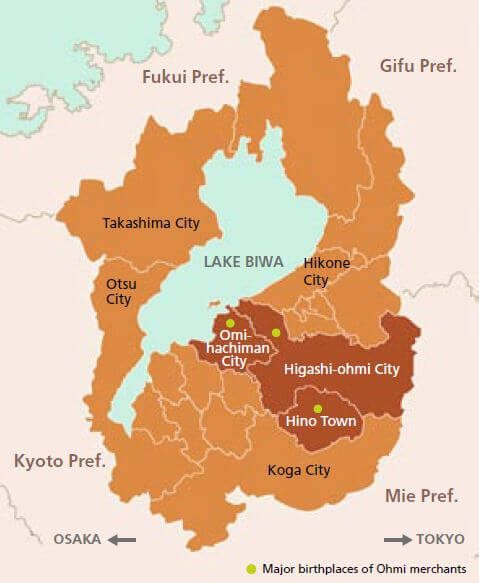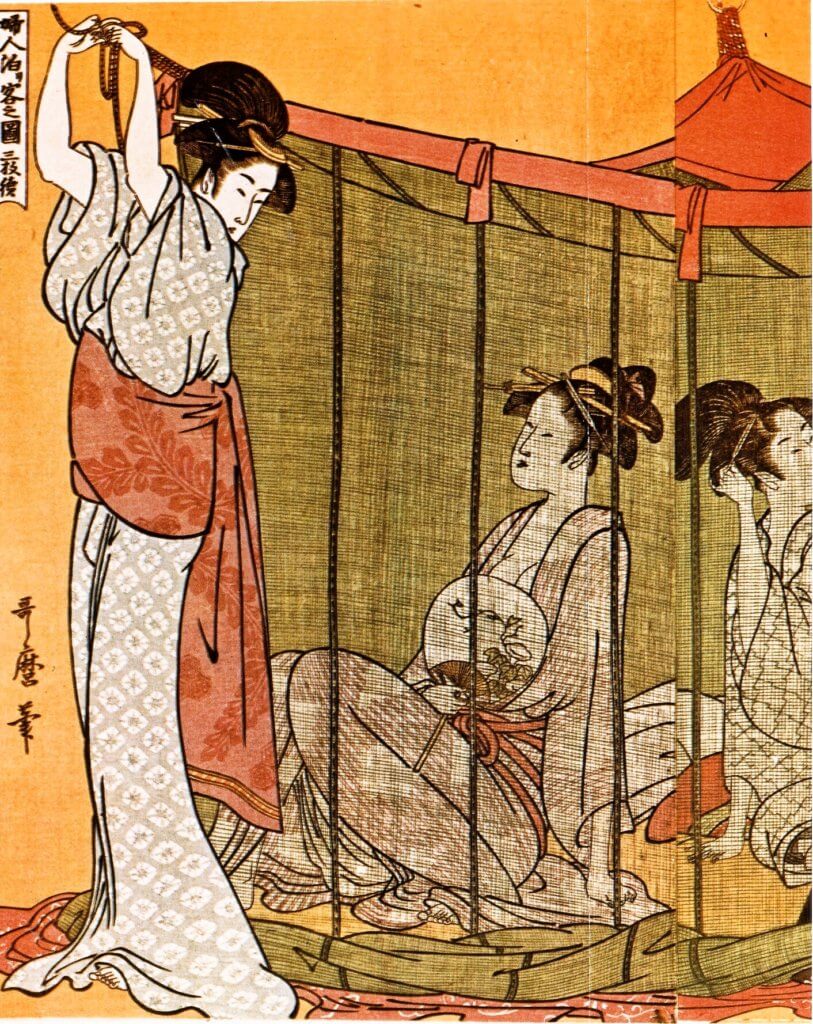Tips for Business Sustainability from Japan's Longest-established Companies
CONTENTS
- Japan has the highest number of companies with longevity in the world
- What is "Sanpoyoshi?"
- Tradition Is the Results of The Continuing Process of Innovation
- Retailers, Consumers and Company Are All on the Same Boat
- Reform #1 Improved Personnel System For Uplifting the Spirit of Challenge
- Reform #2: Challenge of Running the First Retail Store
- Reform #3: Launching More Own Unique Brands
- “For Customers,” and Further Challenges
- The Key to Success: Business is “For the Customer”
Japan has the highest number of companies with longevity in the world
What is "Sanpoyoshi?"
In Japan, the word "akinai" has been in use from long ago. It’s usually translated into English as “business.” However, akinai has a different origin and nuance from business. According to Ohmi merchants, who lived mainly in current Ohmihachiman City and Higashiohmi City, Shiga Prefecture, akinai suggests that while profit is important, it is desirable to do business continuously, and more importantly, implies that to offer the best products and services in terms of quality "on customers' behalf.” The most important thing of all is to work for society and one's community. They were extremely prosperous in the Edo period (1603-1867) and whose business philosophy has been handed down over the centuries to become the cornerstone of modern business in Japan. Even now, such business principles are followed by major business entities such as Itochu Corporation (general trading company), Nishikawa Sangyo Co., Ltd.(producer and distributor of bedding goods and home interior products), Wacoal Corporation (lingerie and female clothes manufacturer and marketer), and Nippon Life Insurance Company. During Japan's pre-modern period, hard work by Ohmi merchants brought wealth and prosperity to their families through their doing business as a traveling peddler. But they were not reputed to be self-serving or scheming. Why? Because there was the management philosophy adopted by Ohmi merchants, known as “Sanpoyoshi” – referring to a win-win business relationship that realized “good seller, good buyer and good society.” Pursuing this philosophy resulted in mutual benefits to the company, its customers and to society as a whole. In modern terms, these tenets would correspond to devotion to customer satisfaction (CS) and serious pursuit of corporate social responsibility (CSR).
Nishikawa Sangyo, founded 446 years ago, is famous throughout Japan for its futon (bedding), bedding goods and other interior products. The company has adhered to the wisdom of its founder and pursued its management philosophy accordingly. We will decipher the secret of success in doing business in current tough business environment, by an interview with Yasuyuki Nishikawa, president of the company, and examining the history.

Framed corporate philosophy “Sincerity, Kindness, Co-prosperity” written with a brush
Business That Results in “Sanpo-yoshi”
Nishikawa Sangyo’s corporate philosophy calls of “sincerity,” “kindness” and “co-prosperity.” As a guiding force the company taps into the precious experience and wisdom accumulated by Nishikawa family heads for many generations. At the root of the concept is the business philosophy known as “Sanpoyoshi,” (“good seller, good buyer and good society”) that forms the motto of the Ohmi merchants, meaning that all three parties should benefit mutually from business activity. A “royal road” to the epitome of management may not actually exist, but Nishikawa Sangyo seems to have reached the pinnacle of success, thanks to its long and prosperous history. We ask Yasuyuki Nishikawa, the current president, about the company’s knacks for successful management, and he replies unhesitatingly: To think of the “customers”, to put yourself in the customers’ shoes, and to make “customers” happy are the most important factors. What Nishikawa has attempted is to talk about the company precepts in contemporary terms to all employees for the company’s future, through the customer’s point of view.
Tradition Is the Results of The Continuing Process of Innovation
President Nishikawa, now 45 years old, succeeded the position of Jingoro Nishikawa, who now serves as chairman, at the time the company celebrated its 440th anniversary six years ago. It was purely by chance that President Nishikawa came to take over the company, through his marriage to Jingoro Nishikawa's niece.
“I have not worked for the company nor was I familiar with the bedding industry and textiles. However, no company can avoid changing along with the changing times,” he admits and thinks. “I couldn’t have imagined I’d become president. So in a sense, I think I am able to view the company objectively and take things calmly, and may be good for the company management. Perhaps Jingoro Nishikawa understood that I was suited for the job and he entrusted me with the task. He advised me, ‘Don’t just stick blindly to traditions or rest on the laurels of our traditions.’ In my understanding, tradition comes from the results of the continuing process of innovation while looking back at the past. That made me think that I should determine clearly what we would keep with us and what we would change,
because I believed both aspects coexisted within the company,” he explains. “I’m not entirely sure, but I suspect that at first some employees may have been skeptical about me, wondering ‘Who on earth is this man?’” he adds.

Ohmi merchants on the map
Retailers, Consumers and Company Are All on the Same Boat
One day while visiting a manufacturing section, it seemed to him that the employees took elaborate measures to ensure that the best quality products would be provided to customers in good faith, although I thought the profit margin would be getting smaller. Yasuyuki Nishikawa had an opportunity to ask a question of why they make in such a way. But they replied, “If we cut corners, it would no longer be a Nishikawa product.” That short conversation made him realize that the code of ‘sincerity’ inside the Nishikawa ‘DNA’ remains even now, after more than four centuries in every section and department of the company.
On the other hand, thinking that employees at production departments sometimes tend to feel self-satisfaction with their products and the results of their work, which could hinder them from further growth and development, Nishikawa decided to clarify the company motto in contemporary and specific terms. He thought that this marked a good opportunity to realize once again the true meanings of the business codes and what they mean to employees, as well as to make them the basis for his management policy and judgment that stemmed from the Nishikawa identity.
“It is fortunate that old reference books on management philosophy and others such as Kanjo-mokuroku have been retained by the Nishikawas. Some of them were written more than 200 years ago. Yet they are surprisingly applicable to modern management, stating that business is always destined to go up in smoke if a merchant only make money for himself, and that one should always be honest not only to the customer but to society,” he says. Furtheremore, it turned out that Nishikawa’s main customers were not the end-users, but retailers such as department stores and their buyers who in many cases do not use the actual products themselves. He learned through question and answer sessions with the employees that their answers to the question “How do consumers like our products?” tended to reflect the opinions of the buyers.
“There was a sense that no one took responsibility for Nishikawa company once the products were shipped, even if retailers maintained large inventories. Nor were we even informed about how products were sold at department stores, to put things in extreme terms,” he expresses his concerns.
Reform #1 Improved Personnel System For Uplifting the Spirit of Challenge
From Nishikawa’s point of view, there was a tendency based on seniority organizational structure, in which employees contented themselves with the unchanged situation. He revised their employee performance evaluation, applicable to the current management system, so that he thought employees will try to work harder with a positive attitude; can establish a track record in accordance with the company policy; and can be promoted in a timely manner enhance their performance levels. In general people are likely to prefer a stable environment, and the original spirit of challenge and motivation to perform higher quality work tends to diminish subconsciously. So the new evaluation system is not strictly a performance-based salary system, but the rating system must be transparent so everyone understands how the employees are evaluated.
Nishikawa continues, “Furthermore, employees who confront new challenges, and who engage in numerous initiatives, trying one way after another, and who steadily achieve a measure of success will be awarded each month. This is an attempt to evaluate the performance on a day-to-day basis.” In addition, Nishikawa has initiated another award system for employees who attempt new challenges, like gathering materials and setting up a database to share that with others. Alternatively, the candidate might be an office worker who makes a favorable impression on the clients over the phone. Candidates are considered based on either their self-recommendation or recommendation by others. “There could always be employees in every department who take up their jobs with gusto. So I ask the department heads and managers to make several recommendations each time,” says Nishikawa. The selection committee, which does not include him, chooses one or two among the nominees. The award recipients are supposed to make a brief presentation about his or her approach to tasks, explaining their motivations and so on, in front of the others, in the expectation this will enhance the awareness of the other employees. Nishikawa believes that the performance-based evaluation system are needed to some extent because of the severe business environment, even though this system might be resisted by some. It will, more importantly, positively affect the motivation of employees.
Reform #2: Challenge of Running the First Retail Store
The company launched its very first retail store. It may seem a violation of the tenets of business for a manufacturer and wholesaler to operate its own retail store, although the store does not sell all its products. However, in Nishikawa’s view, having their own store enables them to understand end-users’ true preferences and trends, as well as to have employees know how difficult it can be to run a retail business: They are able to see what products they should develop for customers, and how they should help the retail stores that sell Nishikawa's products to prosper. Through a change in the way of thinking, the first new lifestyle shop, called ‘Siestarea,’ was created, with a consultant assigned to the premises with expert knowledge about comfortable sleep. The project was conceived by a development team led by female staff. “We also started another project, entrusting a female-led development team to run a new type of a custom-made pillow shop, called ‘PILLOWY café shop,’ offering the perfect pillow for the right fit to each consumer,” Nishikawa adds. “These challenges make it easier to obtain evaluations of our products from end-users directly, which help to introduce new products to our retailers,” he continues.
Such attitudes by Nishikawa toward business are understood by retailers, and department stores and specialty shops. They have opened exclusive Nishikawa sales corners in their stores. In addition, Nishikawa has launched sales of a special mattress named “AiR” (www.airsleep.jp) for athletes, based on the concept of “Sleep for Winning.” The new product was honored with the government’s “Good Design” award. Nishikawa talks about the story behind the creation of the AiR mattress. “I was considering the adoption of unorthodox colors such as brilliant pink to the AiR, which were not normally used for bedding products in this industry. Then suddenly I was struck by an idea. While I was out jogging, I caught a glimpse of the sole of a runner’s shoes. Noting that the sole was brightly colored, it occurred to me that runners wore such colorful shoes even though they themselves could not see the soles when running. Why was this, I thought. It gave me a hint for developing new products. It seems that people tend to feel some satisfaction in the most unexpected places as the part of their lifestyle. Nishikawa Sangyo should pursue this idea for a sleeping mattress, even though they cannot see its color, much in the same as running shoes.” He thinks one of the themes of Nishikawa Sangyo is related to “Sports and Health” and this will be the way of developing new products. Nishikawa thought that the second generation head of his company must have dyed mosquito nets yellow-green with something similar in mind. Prompting a challenging spirit in thinking is very difficult, but this project proved a major turning point, helping employees to realize that the company traditions emanate from the results of continual experimentation, an attitude that pursues the traditional Nishikawa spirit.
Reform #3: Launching More Own Unique Brands
Jingoro Nishikawa, the current chairman, the 14th generation company head, initiated sales of famous brand products under license, first in the bedding industry and another milestone for Nishikawa Sangyo. Currently the company has forged business ties with numerous famous brand products, such as CÉLINE, Etro, Wedgewood, Yves Saint Laurent and others. Further now Nishikawa company is preparing to actively promote its own brands, to show a different and new aspect of Nishikawa to consumers.
“For Customers,” and Further Challenges
We ask Yasuyuki Nishikawa about the management plan and strategies in a
10-or 20-year term. “Consumers do not buy our products every day in the way they would buy food,” he remarks. “They may understand the value of our products by using them for a long time. For example, we cannot see the stuffing inside a futon, comforter, even if coarse materials are used. Nishikawa Sangyo does deliver high-quality products to our consumers, so that they trust us, in accordance with the codes of management as put forth in the ‘Rules of the Company’ that were established hundreds of years ago. There are two things in writing, compliance of laws and attitude of business, which mention ‘In the codes and regulations,’ to the effect that ‘employees will get along with each other, strive to work, sell products on a small commission, do not get an extra commission even if running out of stock,” he explains.
“I think the way of thinking about business and management that Nishikawa Sangyo has maintained for generations would be advantageous. I myself worked for a Japanese bank’s overseas subsidiary, involved in finance and cash flow-based business. I would say the listed Japanese and foreign companies have a tendency to rely on short-term profits. I want to engage in somewhat long-term interest for the future, and not for big profits, as Ohmi merchants did, so as to keep Nishikawa company rolling along toward future generations,” he tells his views. “Bedding is not only a furnishing for sleep, but a thing that helps consumers feel rested and comfortable the next day. Recently as sleep itself has been reconsidered in terms of enhancing beauty and preventing aging, or boosting the immune system and metabolism, Nishikawa established the Japan Research Laboratory of Sleep Science, marking a first time for the bedding industry to be involved in analyzing the efficacy of sleep, and sharing its findings with professionals in other fields. We believe we’ll be able to prove the efficacy of sleep by demonstrating evidence and developing extensive new products for consumers.
“Our first step has been to propose bedding products to top athletes, people for whom good rest is essential. I hope they will be at their peak and make a big success in the Olympics four years from now, the year in which our company observes its 450th anniversary. I am eager to go further to promote these, which may become a part of our core business for hundreds more years,” says President Nishikawa. Sleep is indispensable, and bedding is likely to be the infrastructure that provides a sound sleep. “Unfortunately, even athletes, who are expected to have ‘physical capital,’ do not give enough consideration to the quality of their sleep,” he thinks. “They should arrange for their own bedding to best suit themselves with more scientific analysis of sleep, with the same attention they devote to their diet and training.”
At the conclusion of the interview, Nishikawa shares his thoughts and attitude towards his obligations in order that Nishikawa Sangyo would continue to develop and prosper in the future. “I try to learn and experience a lot for Nishikawa, but I think I myself should maintain my status as a ‘knowledgeable amateur’ in the bedding industry,” he remarks. “Why? Because that will enable me to have different points of view, and perceive things objectively and fairly.”
The Key to Success: Business is “For the Customer”
Five Keys to Overcome Difficulties
According to Teikoku Databank, Japan has 435 long-established companies with histories of over 300 years. One such company, Nishikawa Sangyo is a leader in the bedding industry as well as an established blue-chip company. Nishikawa has survived and overcome numerous difficulties, such as economic crises, wars and natural disasters, based on the “Sanpo-yoshi” business philosophy, that calls for providing mutual benefits to a business, its customers and to society at large – an unchanging aspect of the tradition of Ohmi merchants that has been handed down for generations. Nishikawa Sangyo gives top priority to the policy of “Customer First” and has a steady development by reading the trends of the changing times. The reason behind their success can be categorized into five points.
① Pioneering Spirit, Prescience, Positive Action
The origin of Nishikawa Sangyo dates back to its founder, Nizaemon Nishikawa (1549-1644). The son of a merchant family in Ohmi-hachiman City, located on the eastern shore of Lake Biwa in present-day Shiga Prefecture, Nizaemon started making sales trips from home in 1566, when he was 19. His first products were kaya, mosquito nets, linen and other dry goods. Then he began dealing in other products, such as tatamiomote, straw-matting carpets. Ohmi merchants dealt mainly in textile products that were produced around their home town for sale to people in faraway local areas. They also purchased local specialties in those areas to sell around their home town when returning home, creating an efficient system of domestic trade. Founder Nizaemon had originally started his business at a different place in Ohmi-hachiman from the current location of the Nishikawa residence. He moved there and opened a store as soon as the government guaranteed freedom of trade. It was such a good timing for him to take an action. He instinctively sensed the timing was favorable for doing business. Also, we couldn’t help but think he had business acumen for opening a shop at Nihonbashi, Tokyo in 1615. It still stands on the same location, as Nishikawa’s Tokyo Nihonbashi main store. Such a shop was also a first for merchant from Ohmi and came about only 12 years after Shogun Tokugawa Ieyasu took the reins of government, making Edo (now Tokyo) his administrative capital, where many people would gather in the future. In terms of foresight, it should also be noted that the 13th generation Jingoro Nishikawa introduced a management system he learned while in the United States. He also gave employees an enlightening education, learning bookkeeping, abacus, calligraphy, and English. He must have understood the need for English in his business.
② Innovative Ideas
It was the second generation head of Nishikawa Sangyo who proved to have a flair for design. The founder, Nizaemon Nishikawa, fathered four sons. It was the youngest, Jingoro, who succeeded his father as the second generation head of the company. Jingoro is credited with originating the Ohmi-kaya, a mosquito net dyed in yellow-green with red edging. During the trip, Jingoro took a rest in the shade of a tree. He was suddenly inspired by this brilliant idea when he awoke from dozing off in the shade of a tree, and happened to see beautiful fresh leaves before his eyes. This led him to think that people would feel refreshed in the morning if they saw such colors of netting when they awakened. The mosquito net business helped to establish the foundation for the Nishikawa family’s prosperity, thanks to its strong sales. Hereafter the newly designed mosquito nets became a synonym for mosquito nets until now. Afterwards Nishikawa started to sell straw-matting carpet, thus more than four centuries ago starting to assume the form as an interior designer and manufacturer.

Ohmi-kaya, a mosquito net dyed in yellow-green with red edging
③ Spirit of Challenge, Flexibility
In the same spirit of challenge in which Nishikawa opened its branch store in Tokyo in 1615, the company expanded with a totally different item, yumi, the archery bow, through its acquisition of a bow wholesaler. Nishikawa’s bow business scored a success in Edo, because samurai warriors needed bows and the company’s fifth generation head anticipated a great demand for them. It should be noted the sales of “futon” established the existence of the current Nishikawa Sangyo. Futons were
made by every house in-house at that time. It was in 1887 that Nishikawa ventured to launch the sales of all-season bedding. This greatly contributed to the stabilization of sales, since mosquito nets is only in demand around summer. Once again through the spirit of challenge the company’s innovation for consumers made it a pioneer in the bedding market.
As for mosquito nets, the company steadily increased sales by expanding the overseas to Southeast Asian countries, such as Singapore in 1917, and subsequently to Africa and South America.
④ A Keen Sense of Management, Crisis Management, Financial Statements
A financial report is a formal record of business activities, providing information about a company’s financial status and performance. Risuke Nishikawa, the third generation family head, had already run a business making efficient use of the report more than 300 years ago. The report including inventory, called Kanjo-cho, the oldest existing accounting book in Japan, was submitted twice a year to the head store in Ohmi.

three types of saving account book by the Nishikawas, in which the first bonus system in Japan was established
Enactment of Bonus System
The family head, whose excellent management skills earned him the reputation as the restorer of the Nishikawas, was Risuke Nishikawa, the seventh generation head. In 1789 Risuke created an epoch-making human resource system called mitsuwarigin-seido, the first bonus system in Japan, paid out to employees twice a year. One-third of the net profit was allocated to employees as a bonus, another third for the company’s internal reserves and the remaining third for the head office (now stakeholder). For employees, that meant that the harder they worked, the larger their bonus, and the more the company’s cash flow improved as well.
However, after Risuke was succeeded by the eighth generation head, some employees tended to enjoy themselves too much and splurged their bonuses gratuitously. So the head office decided to retain their bonus until they leave the company or set up a branch, besides allowing them to draw pocket money for their daily life when needed. This way they could receive their deposited bonuses with interest. This system became the forerunner of the modern corporate pension system.
Raising the Reserve Fund
A saving-type insurance system was also established in the Edo period for the first time, because people lost all their household goods in a fire in Edo, where fires and feuds frequently occurred. Actually, Risuke Nishikawa lost two stores to out-of-control fires. The purpose of the system was to rebuild stores if they suffered from
accidental disasters, and offered three types of insurance funding: for reconstruction, for religious ceremonies and emergencies. The system has been carried over until now, being officially documented in 1799.
Establishing Business Compliance
Nishikawa Sangyo already adopted the use of consolidated and harmonized
sets of compliance controls involving three parties – the head office, branches and family relatives – to ensure all necessary governance requirements could be met and sharing of responsibility, so that the company’s results would improve.
The head office also gave employees the opportunity to set up a branch if they worked hard and demonstrated managerial ability. Thus some employees were motivated by the possibility of someday having their own shop.
⑤ Social Contribution
In 1993, the company’s 14th generation head, Jingoro Nishikawa – the current Chairman & CEO – set up the Nishikawa Cultural Foundation to contribute to society and communities through cultural and educational support. This was conceived as a means to express gratitude to the public for supporting Nishikawa Sangyo. The company’s philanthropy is also based on the traditional “Sanpo-yoshi” management philosophy touched on previously in this article.
One story about Nishikawa’s social contributions dates back to September 1923, when the Great Kanto Earthquake devastated Tokyo and surrounding areas, causing widespread damage, with an estimated 143,000 deaths. The 12th generation head, Jingoro Nishikawa, made efforts to re-open the Tokyo Store as soon as possible for victim relief, and commenced reconstruction of the store, thinking and acting flexibly, because bedding and related goods were in short supply.
In response to the emergency he requested other branches to expedite delivery of blankets and other bedding products, just as the Ohmi merchants would have done in olden times. Thanks to this flexible supply system, not only were survivors overjoyed to receive goods quickly, but the company minimized the impact of the damage. More recently Yasuyuki Nishikawa, the current president and C.O.O.,
made a similar contribution to victims of the Great East Japan Earthquake in March 2011. Nishikawa says, “Depending on the quantity and thinking of management, we were happy to take the necessary measures to assist victims as soon as possible, because an emergency situation is totally different from ordinary times. We just think about our management in the long term in such a case, and I felt that I was doing my best to emulate the wisdom of our company’s earlier leaders. Our motto is to contribute to society and to help customers, expressing our gratitude for supporting us.”


